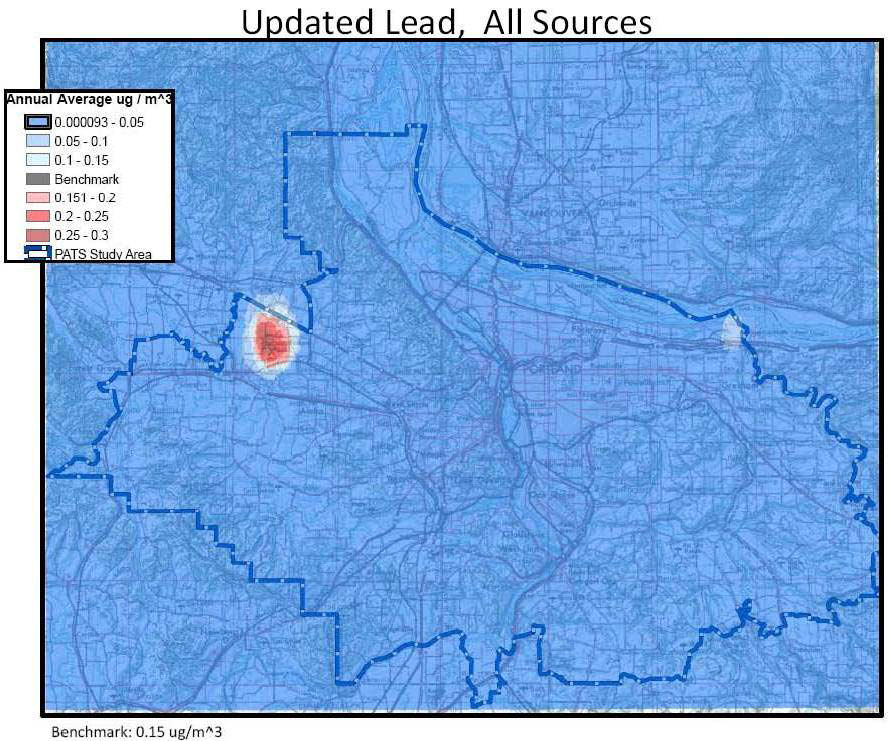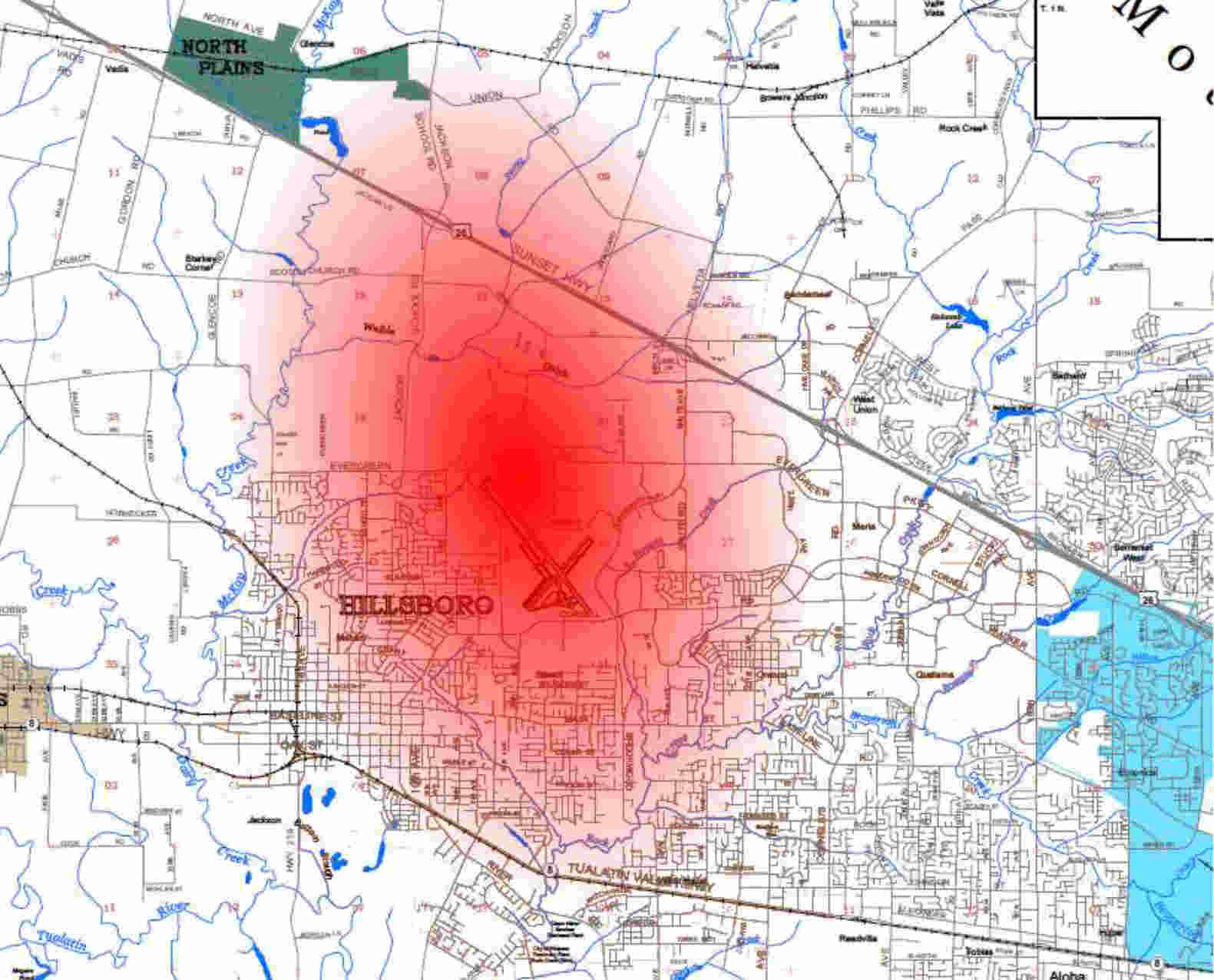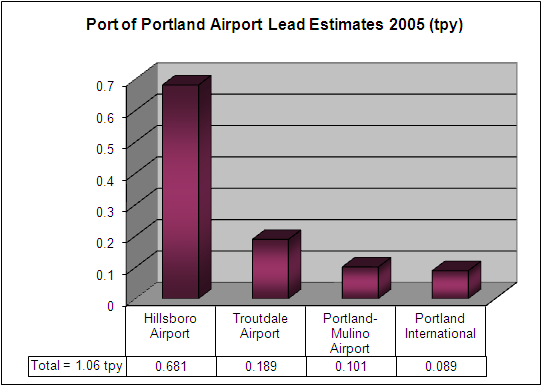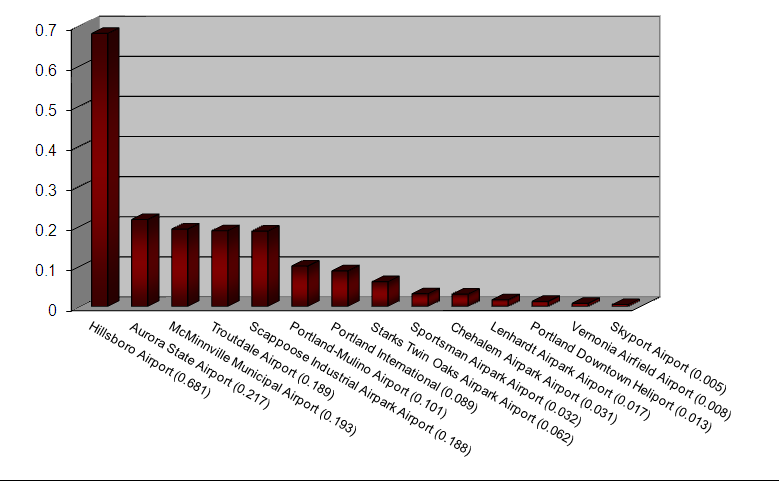Aviation Lead Cloud Over Oregon
April 4, 2012
In March of this year, Friends of the Earth and EarthJustice sued the Environmental Protection Agency (EPA) for failure to enforce their own regulations regarding lead emissions--specifically lead emissions from general aviation aircraft. The fact is that the majority of Americans don't know that aviation gasoline (avgas) still contains lead, and that lead emissions from these aircraft constitute a public health hazard.
Piston-engine aircraft, a category which includes most general aviation aircraft, both fixed wing and helicopters, as well as air taxis for the transport of passengers and freight, are responsible for emitting nearly 50 percent of the lead toxins released into the air in this country. Lead was eliminated from automotive fuel more than 15 years ago. Nonetheless, despite well known negative health and environmental impacts, lead is still added to aviation fuel to boost octane and prevent engine knock.[1] Findings by the EPA and other researchers reveal that, "Lead concentrations in air increase with proximity to airports where piston-engine aircraft operate."[2]
Oregon residents are significantly impacted by lead emissions from the more than 450 airports throughout the state.
Lead Cloud Over Hillsboro
Hillsboro Airport (HIO) in particular, the largest general aviation airport in Oregon with close to a quarter million operations (take-offs and landings) per year, is a major contributor. Piston-engine aircraft comprise the majority of operations at this facility. Of the more than 20,000 airports in the U.S.,[3] HIO ranks in the top one percent in lead emissions. On a list of the 58 U.S. airports that generated more than 0.50 tons of lead in 2008, HIO was 21st.[4]
In 2005 the Oregon Department of Environmental Quality (ODEQ) released a map depicting a lead cloud hanging over the Hillsboro Airport and surrounding community. According to the National Ambient Air Quality Standards (NAAQS), 0.15 micrograms per cubic meter is the standard benchmark level for lead in the air.
General aviation airports like HIO that cater primarily to aviation hobbyists and private flight training businesses are often major producers of this pollutant, largely because these airport users frequently engage in repetitive flight training exercises within relatively close proximity to the airport. Commercial jets by contrast use jet fuel, which does not contain lead.
The ODEQ map below, based on estimated HIO lead levels, indicates that in 2005 the vicinity in and around the Hillsboro Airport exceeded ODEQ's benchmark level of 0.15 micrograms per cubic meter by a substantial margin. The red to pink coloring represents areas that exceed the benchmark. Areas at benchmark and below are said to pose "negligible risk of harm to human health."[5]

The method utilized by ODEQ in creating this map was an EPA preferred and recommended CALPUFF model described as "a non steady state puff dispersion model...that can be applied for long-range transport and for complex terrain."[6]
ODEQ documentation revealed that the high emission levels were serious enough to warrant the placement of an actual monitor to measure lead, rather than relying solely on estimates.[7] Unfortunately, due to a 12/14/10 revision in lead monitoring, even though industrial sources are required to monitor when lead emissions exceed 0.5 tons per year, airport lead sources were granted a waiver. Per the EPA, aviation facilities are required to monitor rather than estimate only if emissions exceed 1.0 ton per year.[8] This, of course, creates an incentive for airport owners and operators to underestimate emissions.
The following is an illustration of the same lead cloud laid over a more detailed map, at approximately the same scale, for the purpose of making the extent of lead emissions more meaningful.

It is worth noting that lead emissions from HIO estimated in the ODEQ illustration consider only the landing and take-off (LTO) cycle, which includes taxi/idle-out, takeoff, climb-out, approach and taxi/idle, but excludes run-ups (test and maintenance procedures prior to take-off ) and the cruise phase, which are also significant sources of lead emissions.
Port of Portland Lead Emissions in 2005
The graph below shows that the Port of Portland's owned and operated aviation facilities, when combined, emitted over a ton of lead into the environment in 2005. HIO alone emitted nearly twice as much lead as the other three put together. Please note that the Hillsboro Airport Third Runway Draft Environmental Assessment indicates that by 2007 HIO lead levels had climbed to 0.7 tons per year based on 10 minutes of taxi/idle time.[9]

Click on http://oregonaviationwatch.org/docs/Airport_Pb_Estimates_2005.pdf for a DEQ listing of estimated lead emissions at 100 Oregon airports.
Why Does HIO Emit More Lead Than Any Other Airport in Oregon?
One of the main reasons is because a primary tenant at HIO, Hillsboro Aviation, runs an international flight training school that recruits student pilots from around the globe. Per their website this for-profit business "has trained thousands of pilots from over 75 countries."[10] Among their accomplishments they list the following:
- The Airline Pilot Association of Taiwan chose Hillsboro Aviation as its premier location to train.
- The Japan Aviation Academy chose Hillsboro Aviation as their exclusive pilot-training school.
- Shanghai Airlines chose Hillsboro Aviation to train its pilots.
- China Eastern Airlines chose Hillsboro Aviation to train its pilots.
- Air China chose Hillsboro Aviation to train its pilots.
- PTES (Cessna's single-engine piston airplane and Robinson helicopter dealer in China) chose Hillsboro Aviation as its U.S. aviation partner.
- Luftfartsskolen School of Aviation in Norway chose Hillsboro Aviation to train its pilots.
- Hillsboro Aviation is consistently rated in the top 11 worldwide for Cessna Pilot Center (CPC) schools.
- The CAAC (Chinese government) approved Hillsboro Aviation to conduct both airplane and helicopter training.
Hillsboro Aviation also boasts that the pilot training portion of their business logs 55,000 flight hours per year, which translates into, on average, six aircraft in the air 24 hours per day, 7 days per week, every single day of the year.
Lead Emissions from Oregon Airports
A number of other airports both within Washington County where HIO is located and in surrounding jurisdictions including Multnomah, Clackamas, Columbia, Marion and Yamhill counties, also emit a substantial amount of lead. And like HIO, many of these facilities engage in flight training including Aurora, McMinnville, Troutdale, Scappoose, and Stark's Twin Oaks.
The graph below illustrates the lead emissions in 2005 for all airports within a 25 mile radius of HIO. In that year, the entire region was subjected to 1.826 tons per lead.

(total = 1.826 tpy)
The Port of Portland and ODEQ estimates, as shown in the preceding maps and graphs and noted on the list of Oregon airports, consider only emissions from the Landing and Take-off (LTO) cycle while ignoring emissions in the cruise and run-up phase. As a result these estimates don't begin to convey the actual amount of lead emitted by aviation activity in Oregon in any given year.
The map below depicts airports within a 25 mile radius of HIO. The red circles represent airports included in the ODEQ list of the top 100 Oregon airports in lead emissions. Blue circles represent smaller airports that also contribute to lead pollution throughout the area. It is important to bear in mind that due to excessive aviation activity, the skies throughout the entire region are frequently crisscrossed with student pilots and general aviation hobbyists.

Port of Portland Lead Study
In an effort to counter ODEQ's findings, as shown in the ODEQ lead map above, the Port of Portland initiated its own study by commissioning a private consulting company, CDM.[11] It does not appear that community input or feedback was solicited for this study. Rather than actually monitoring lead emissions in an effort to insure the health and well being of the community, the Port opted to estimate the numbers in such a way as to deny that HIO's aviation activity exceeded the benchmark levels as depicted in the ODEQ 2005 map.
Their argument was based on the assertion that the CALPUFF model utilized by ODEQ in 2005 was overly focused on ground sources of lead emissions and did not take into consideration the Port's contention that aviation generated lead is dispersed into the environment rather than concentrated around the airport.
In making their claim they chose to use a different modeling system, AERMOD, which is an approved EPA model, in combination with the Emission and Dispersion Modeling System (EDMS). However, the EDMS model has serious drawbacks. According to the EPA, "EDMS has a limited number of piston engine aircraft in its aircraft data and is currently not set up to calculate metal emissions and thus, it is not a readily available tool for determining airport lead emissions related to aircraft operations."[12]
In any case, by utilizing this model, the report concluded that even though HIO emits more than 0.632 tons of lead into the environment each year, it does not exceed the ODEQ established benchmark level of 0.15 micrograms per cubic meter. Though ODEQ openly admits that it "has not conducted an analysis to compare the study to its Portland Air Toxics Solutions model,"[13] it appears that this agency accepted the Port's study and as a result is now projecting a 2017 Lead Sources map in which the lead cloud over HIO magically disappears with no testing whatsoever and nothing more than the tap, tap, tap of a few computer strokes.
A fact of note is that all of the previously cited EPA and other source data on lead emissions are not based on measurements. Rather, it is based on modeling which calculates the amount of lead emitted, and the dispersal of that lead, on the amount of avgas sold and burned at specific airports. The critical public health component missing in all of this is actual measurements to confirm the estimates, as well as to determine the accumulated amounts of lead in soil, and to assess the impact of this lead on ground water and underlying aquifers.
To arrive at their conclusions, the Port's CDM report conveniently ignored some of the findings included in a Santa Monica Airport analysis on lead emissions - a study which involved monitoring air, soil and dust concentrations of lead at seven sites on and in the vicinity of the airport.[14] Santa Monica is a general aviation airport that logs approximately 100,000 operations annually, less than half as many as HIO. The study ultimately identified "Four factors found to most highlyinfluence air lead concentrations":
- Engine "run-up" check duration [a run-up is an engine check that occurs prior to take-off]
- Taxi-out time
- Fraction of twin-engine aircraft
- Lead concentration in the fuel "The two samples of avgas had lead concentrations 20% higher than the ASTM specification."[15]
Another issue that is poorly addressed by the Port study is its failure to factor in cruise phase lead emissions. On this topic, the EPA notes, "Because lead is a persistent pollutant and accumulates in the environment, we include all lead emissions from piston-engine aircraft...emissions occurring during the landing and-take-off at airports as well as emissions occurring at altitude."[16] The 2008 EPA National Emissions Inventory (NEI) calculated that in addition to the lead emitted by individual Oregon airports during the landing and take-off phase, an additional 5.30 tons per year was emitted statewide for aircraft in the cruise phase.[17]
It is reasonable to assume that a significant portion of the cruise phase emissions are concentrated over Hillsboro and surrounding communities since more than two-thirds of the aviation activity at this facility is categorized as local flights, predominantly touch and go training operations, which by definition fly within four to five miles of the airport at an altitude of 2,000 ft. or less. Other local flights also involve training activities at designated areas within 20 miles of the airport. In addition, there are a number of itinerant operations, described as "originating or departing aircraft"[18] which fly from one airport to another. A number of these are student pilots who accumulate training hours by flying from HIO to Scappoose, Stark's Twin Oaks, Aurora, McMinnville, Chehalem, Troutdale and the other training airports throughout the region.
Concluding Remarks
Lead is a toxin. It was removed from auto gas and paint for a reason. Specifically, accumulated levels of lead in human tissues can cause negative cognitive impacts in children. At present approximately 50% of emitted lead comes from the burning of avgas.
According to the EPA, "Children are particularly vulnerable to the effects of lead. Exposures to low levels of lead early in life have been linked to effects on IQ, learning, memory, and behavior. There is no identified safe level of lead in the body."[19]
The environmental group, Friends of the Earth, issued the following warning:
"... even small discrete doses from aircraft emissions can have long term health and environmental impacts... Piston-engine emissions of lead occur at ground level as well as flying altitude. Lead from this source is thus concentrated near airports and is also dispersed over a large geographic area potentially contributing to higher ambient concentrations in many communities. Numerous groups within the population may be at risk."[20]
At the very least, it is essential that airports throughout Oregon monitor and test, rather than simply estimate, lead levels in the air, soil, and water. In addition a data bank of blood lead levels in children needs to be gathered to determine the extent to which children subjected to piston-engine air traffic may be adversely impacted by lead toxicity. Particularly in light of the recent Duke University study in North Carolina finding that "living within 1000 m [2/3 mile] of an airport where aviation gasoline is used may have a significant effect on blood lead levels in children. Our results further suggest that the impacts of aviation gasoline are highest among those children living closest to the airport."[21]
Optimally, the non-essential use of leaded aviation fuel must be prohibited without delay. The Center for Disease Control has concluded, "...because no level of lead in a child's blood can be specified as safe, primary prevention must serve as the foundation of the effort [to eliminate childhood lead poisoning]."[22] Continuing to allow the use of lead in avgas is unconscionable and irresponsible as this potent neurotoxin jeopardizes our children's physical and mental health. The time is now to stop polluting our communities with aviation lead.
Sources
[1] Calculating Piston-Engine Aircraft Airport Inventories for Lead for the 2008 National Emissions Inventory. EPA-420-B-10-044. (December 2010). Pg.1. http://www.epa.gov/otaq/regs/nonroad/aviation/420b10044.pdf. (If your browser reports a "damaged document," try this Alternate Link).
[2] Advance Notice of Proposed Rulemaking on Lead Emissions from Piston-Engine Aircraft Using Leaded Aviation Gasoline: Regulatory Announcement. EPA420-F-10-013, (April 2010) http://www.epa.gov/nonroad/aviation/420f10013.pdf.
[3] Ibid.
[4] Click on 11/1810 EPA Memorandum from Marion Hoyer and Meredith Pedde to the Lead NAAQS Docket EPA-HQ-OAR-2006-0735, (pg. 2-3) for a complete listing.
[5] Portland Air Toxics Solution Project Modeled Lead Data and the Hillsboro Airport. Department of Environmental Quality. (1/20/12).
[6] Technology Transfer Network: Support Center for Regulatory Atmospheric Modeling. Preferred/Recommended Models. Environmental Protection Agency. http://www.epa.gov/scram001/dispersion_prefrec.htm.
[7] Barnack, Anthony. 2010 Oregon Annual Ambient Air Monitoring Network Plan. (July 2010). Pg. 27.
[8] Revisions to Lead Ambient Air Monitoring: Fact Sheet. http://epa.gov/oar/lead/pdfs/Leadmonitoring_FS.pdf.
[9] Hillsboro Airport: Parallel Runway 12L/30R Draft Environmental Assessment. Volume 2. Appendices. Prepared for the Port of Portland by CH2MHILL. (October 2009). Section. C-3. Pg. 1 and 2.
[10] Hillsboro Aviation website. http://www.hillsboroaviation.com/en/page/about_us_why_hai.
[11] Port of Portland Hillsboro Airport Lead Study. Prepared by CDM. (9/1/10).
[12] Calculating Piston-Engine Aircraft Airport Inventories for Lead for the 2008 National Emissions Inventory. EPA-420-B-10-044. (December 2010). Pg. 11. http://www.epa.gov/otaq/regs/nonroad/aviation/420b10044.pdf.
[13] Portland Air Toxics Solution Project Modeled Lead Data and the Hillsboro Airport. Department of Environmental Quality. (1/20/12).
[14] Den, Arnold. Final Results from EPA’s Lead Modeling Study at the Santa Monica Airport. (February 22, 2010). http://www.smgov.net/uploadedFiles/Departments/Airport/CommissionMeetings/EPA%20Lead%20Modeling%20Study%20Presentation.pdf. (If your browser reports a "damaged document," try this Alternate Link).
[15] Ibid. Pg. 17.
[16] Calculating Piston-Engine Aircraft Airport Inventories for Lead for the 2008 National Emissions Inventory. EPA-420-B-10-044. (December 2010). Pg. 2.
[17] Ibid. Pg. 18-19.
[18] Port of Portland. Hillsboro Airport 2005 Master Plan. Pg.1-6.
[19] U.S. Environmental Protection Agency. (April 2010). Advance Notice of Proposed Rulemaking on Lead Emissions from Piston-Engine Aircraft Using Leaded Aviation Gasoline: Regulatory Announcement. Background section. (EPA420-F-10-013). http://www.epa.gov/nonroad/aviation/420f10013.pdf.
[20] Friends of the Earth. EPA Proposes Rule to Phase Out Lead from Aviation Fuel. (April 22, 2010). http://www.foe.org/news/news-releases/2012-03-environmental-group-sues-epa-to-get-the-lead-out-of-aviation-gasoline.
[21] Miranda ML, Anthopolos R, Hastings D 2011. A Geospatial Analysis of the Effects of Aviation Gasoline on Childhood Blood Lead Levels. Environmental Health Perspectives (ehp) 119:1513-1516. Conclusions Section. (7/13/11). http://dx.doi.org/10.1289/ehp.1003231.
[22] Preventing Lead Poisoning in Young Children. A Statement by the Centers for Disease Control and Prevention, (August 2005). pg. 1. http://www.cdc.gov/nceh/lead/publications/prevleadpoisoning.pdf.
| © Oregon Aviation Watch | Contact Us |  Jump to Top Jump to Top |
